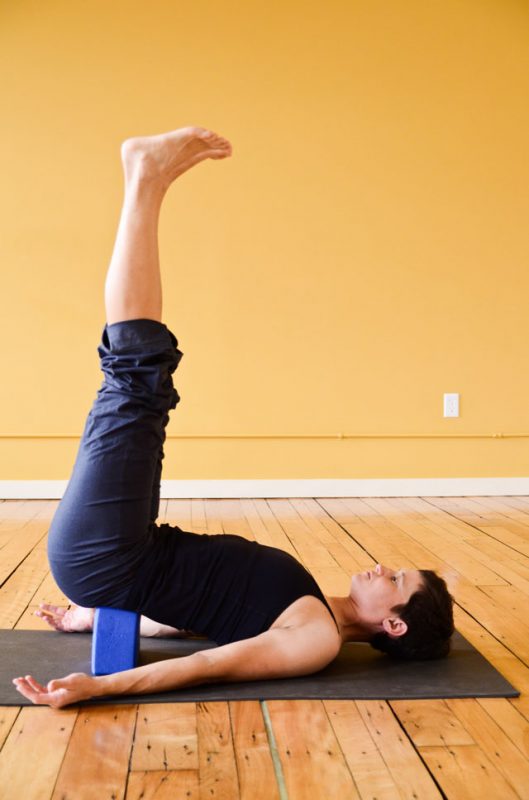Blast From the Past: Yoga for Mountain Bikers
Originally posted on September 8, 2016 at 7:00 am
Editor’s note: This article first appeared in Dirt Rag Issue #164, published in July 2012. Written by Jenn Childress and Jennie Date, with photos by Hilary Hess.
Yoga is everywhere: packed studios, tropical vacations and huge music festivals. Why is it so popular? And why should you, a dyed-in-the-wool mountain biker, care?
Mountain biking and yoga might seem like an odd pair. The first creates visions of chiseled calf muscles, scarred elbows and ripping down trails, while the second brings to mind a lithe figure with eyes closed, hands clasped in front of the heart, chanting “OM.” At first glance, the only common denominator between mountain biking and yoga is the presence of Lycra. But did you know that yoga could be the recovery tool you need to feel your best on the bike?
When you get home from a long ride you’re tired and your muscles ache. Most of us tend to rehydrate and replenish sugars but neglect to care for our muscles, resulting in an incomplete recovery. Our bodies eventually begin to break down and performance declines. Many endurance athletes and coaches agree that a cool-down repertoire of low intensity movement improves recovery. Called “active recovery,” a cool-down routine like this increases blood flow, alleviates muscle inflammation, and eliminates metabolites such as lactic acid, all of which encourage faster soft tissue repair. This is where yoga can help you as a rider.
Yoga serves as a quick and easy recovery tool that can be effortlessly incorporated into your post-ride routine. Just 10 minutes of post-ride mindfulness on your mat will open the areas that tighten during biking—specifically, the hips, legs, lower back and shoulders. At the same time, it strengthens your core and improves flexibility, which helps to correct imbalances caused by the repetitive motion and posture of cycling. Long holds and inversions flush lactic acid out, relieving some of the soreness in overworked leg muscles. Chest openers release tension in the upper back and neck, encouraging deeper breathing and a more relaxed stance on the bike.
Yoga isn’t just stretching. Sure, that’s one aspect, but it is the synchronicity of breath and movement that defines its difference. Proper breathing helps your body deliver oxygen more readily to the bloodstream, which helps refuel the body and eliminate toxins more efficiently. Also, coordinating your movements with your breath leads to greater focus on the task at hand, inviting your body to truly relax and absorb the healing properties of each pose.
Tuning into your breath is the first step to acquiring the mental benefits of yoga. Inner reflection helps you overcome obstacles. It greatly enhances your self-awareness, which in turn transforms your cycling technique and demands that you train intelligently. The single most important thing that yoga can teach you about recovery is to listen to your body.
Trials rider Ryan Leech illustrates how the mental aspects of yoga directly impact your experience on the bike: “Focus and concentration are strengthened through yoga practice; it’s like a muscle, so it takes development, it takes cross-training … perhaps developing a little more mental muscle is the best thing for your riding progression.”
Try this simple sequence after your next ride. Focus your complete attention on your breath and movements.

Mountain Pose
Why: Offers stability, relaxed power and the stillness of a mountain. Use your full attention to bring your body into correct standing alignment.
How: Place your feet evenly and press them into the ground. Stand tall with the legs engaged, the belly button contracted gently towards the spine, the shoulders dropping away from the ears, arms relaxed and the chin parallel to ground. Relax and direct your attention to your breath. Be here for 10 breaths.

Standing Forward Fold
Why: Opens up the chest, hamstrings and lower back in one motion.
How: Inhale and clasp your hands behind you or use a strap, palms reaching together. Exhale and fold forward from the hips, bending the knees slightly as necessary. Extend through the spine, relax your head and work towards straightening your legs. Press down into your feet and lift the knuckles up towards the ceiling. Stay for 10 breaths. Release the hands and come out slowly.

Child’s Pose
Why: Releases the back and neck, gently stretches the quadriceps and hips.
How: Come down to your hands and knees. Spread your knees wide but keep big toes touching, fold your sit bones back onto the heels, sink your weight down, and rest your forehead on the floor. Arms extend out in front of you. Relax completely for 10 breaths.

Ankle-to-Knee Pose
Why: Increases mobility and improves circulation in the hip joint.
How: Lie down on your back. Bend your knees and place your feet flat on the floor. Bring your right ankle to the top of your left quadriceps. Bring the left hand to the left hamstring, and the right hand between the thighs and through to hold on to your left hand. Pull gently to stretch the outer right hip. Press your shoulders and lower back into the ground. Take 10 deep, slow breaths and switch sides.

Supported Half-Shoulder Stand
Why: Elevates the legs, improves circulation, drains lactic acid and generally relaxes your whole body.
How: Lie flat on your back and lift your legs straight up in the air. Relax completely. If you have a block, place it directly under your butt (pictured). Or find a wall, scoot your butt right next to it and swing your legs up. Stay 10 minutes.
Keep reading
We’ve published a lot of stuff in 27 years of Dirt Rag. Find all our Blast From the Past stories here.